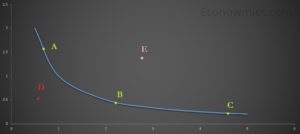Indifference curve
The universe seems neither benign nor hostile, merely indifferent.
Carl Sagan
Suppose that there are only two types of goods which you, as a customer, buy and use. What amount would you prefer to buy from each one of these two goods? Why? Yeah, for sure, there are far more than just two goods in the basket of every household, but since we are trying to plot this graph on 2 dimensions, we consider an example of only two goods.
Indifference curve is a set of combinations of two goods that gave the buyer or the customer equal satisfaction, or to put it in economic terms, equal utility. Moving along this so-called indifference curve, each point has the same utility for the customer and he/she is totally indifferent between the possible combinations.

Take a look at the above indifference curve. Points A, B and C all give equal satisfaction to the customer and therefore he would be completely indifferent between choosing any of them. Point D also shows a possible combination of the goods, but it is not desirable for the customer since it gives less satisfaction than the points on the indifference curve. Point E, on the other hand, has a higher satisfaction than rest of the points, but is not reachable due to the existing conditions of the customer, such as earnings or budget limit.
Considering that each indifference curve shows a level of satisfaction, by using several indifference curves we can illustrate different levels of satisfaction. These graphs, showing different levels of utility for a same bundle of goods and representing consumer’s preferences are called an indifference map. It is obvious that a higher curve shows a higher level of satisfaction.
Indifference curves have specific properties:
Indifference curves are negatively sloped: this means that indifference curves always slope down. This is due to the reason that an increase in the amount of a good come together with decrease in the quantity of the other good. This results in the same level of satisfaction all along the curve. They also cannot be horizontal, since this means that one of the goods is kept constant while the other one changes which is against the definition of the indifference curves.
Indifference curves are convex to the origin: This characteristic of indifference curves is a result of diminishing marginal rate of substitution. Marginal rate of substitution (MRS) is the rate at which a consumer is willing to give up one good in exchange for another good while keeping the level of satisfaction the same. So, an indifference curve gets flatter as we move right along the curve, since the MRS of one good for the other one becomes smaller and smaller.
Indifference curves of the same individual cannot intersect each other: According to the definition, all the points on a certain indifference curve represent the same amount of utility. So, if two curves cut each other, they have one common point, which means that all the points on each of those lines are representing the same amount of utility, which obviously cannot be true.
Also watch
Further reading
Indifference curves and marginal rate of substitution
